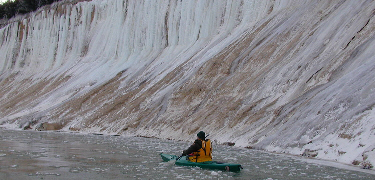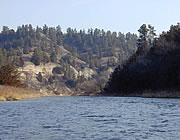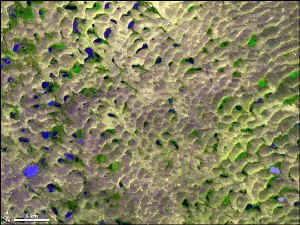Nebraska

Niobrara Scenic River - photo US National Park Service
 Nebraska
Nebraska
On March 14, 2010 the Eastern Native Tree
Society and Western Native Tree Society switched from discussion lists
on Google Groups to a new discussion list in a Bulletin Board format at:
http://www.ents-bbs.org/index.php Posts made since the inception
of the BBS on March 14, 2010 will be sorted and archived on the BBS.
Click on the link to go to the equivalent section on the new BBS. This
website will continue to serve as a front end for the ENTS and WNTS
groups. It will continue to serve as a repository of older posts, and
will serve as the host site for special projects and features that are
not well suited for a BBS format. Please visit the BBS for the latest
information and trip reports.
Field Trips and Discussions
 Niobrara National
Scenic River http://www.nps.gov/niob/
This 76-mile reach of the Niobrara River in northcentral Nebraska was added to the nation's Wild and Scenic River System in 1991. The river is swift and shallow over much of its length, cutting through bedrock forming riffles, rapids and waterfalls. The Scenic River preserves a superb example of a Great Plains river and protects a unique ecological crossroads where six distinct ecosystems and their associated flora and fauna mix, some at or beyond their normal geographic limit.
Niobrara National
Scenic River http://www.nps.gov/niob/
This 76-mile reach of the Niobrara River in northcentral Nebraska was added to the nation's Wild and Scenic River System in 1991. The river is swift and shallow over much of its length, cutting through bedrock forming riffles, rapids and waterfalls. The Scenic River preserves a superb example of a Great Plains river and protects a unique ecological crossroads where six distinct ecosystems and their associated flora and fauna mix, some at or beyond their normal geographic limit.

Ponderosa pine forest at the Ft.
Niobrara National Wildlife Refuge. Photo by Darryn Witt - NPS
Three major forest types converge in the Niobrara River valley: ponderosa pine, eastern deciduous, and northern boreal. Ponderosa pine forest is at its eastern limit in the river valley. The nearest designated forest area containing ponderosa pine is located in the Black Hills in South Dakota. Eastern deciduous forest has extended up the valley and includes bur oak, American elm, black walnut, green ash, basswood, and hackberry. Broadleaf shrubs and vines include sumac, western snowberry, gooseberry, wild plum, and wild grape. Northern boreal forest is found on cool, moist, north facing slopes and includes paper birch, a hybrid species of quaking and bigtooth aspen (the Niobrara Valley is the only known area where this species occurs in Nebraska), ferns, and several species of club mosses. These plants apparently have survived as relicts of the Pleistocene ice age, when they were more widely distributed on the Great Plains.
 Nebraska Forest
Service http://www.nfs.unl.edu/
Forests and trees are an important resource in Nebraska. The native and planted woodlands of Nebraska provide benefits for all citizens, including protection for our valuable soils, recreational opportunities, wildlife habitat, wood products, and beauty. The Nebraska Forest Service is a part of the University of Nebraska and provides education and services to the people of Nebraska covering all aspects of planting, protection, care, and utilization of our forest and tree resources. In addition, the Fire Control Program, through its work with Volunteer Fire Districts, helps provide fire protection to all rural lands including rangeland and cropland. Nebraska Forest
Service http://www.nfs.unl.edu/
Forests and trees are an important resource in Nebraska. The native and planted woodlands of Nebraska provide benefits for all citizens, including protection for our valuable soils, recreational opportunities, wildlife habitat, wood products, and beauty. The Nebraska Forest Service is a part of the University of Nebraska and provides education and services to the people of Nebraska covering all aspects of planting, protection, care, and utilization of our forest and tree resources. In addition, the Fire Control Program, through its work with Volunteer Fire Districts, helps provide fire protection to all rural lands including rangeland and cropland.
 Nebraska Champion Tree
Program http://www.nfs.unl.edu/CTProgram.htm Nebraska Champion Tree
Program http://www.nfs.unl.edu/CTProgram.htm
 GORP - Nebraska
Wilderness http://gorp.away.com/gorp/resource/us_wilderness_area/ne.htm
Fort Niobrara and Soldier Creek. GORP - Nebraska
Wilderness http://gorp.away.com/gorp/resource/us_wilderness_area/ne.htm
Fort Niobrara and Soldier Creek.
 Soldier Creek
Wilderness http://www.fs.fed.us/r2/nebraska/units/prrd/soldier.html
The 7794-acre Soldier Creek Wilderness was added to the National Wilderness Preservation System when Congress passed the Nebraska Wilderness Act in 1986. The area was previously part of the Fort Robinson Military Reservation. On July 8, 1989, lightning ignited the Fort Robinson Fire, which burned 48,000 acres of private, state, and federal lands, including much of Soldier Creek Wilderness, before it was controlled three days later. The fire burned much of the ponderosa pine in the uplands and among the buttes, but there are a few surviving pockets that will provide seed for new trees as the healing process continues. Since the fire burned less intensely in the southeast part of the Wilderness and the lower draw bottoms, more trees survived in these area. Many hardwood trees and shrubs have sprouted from their roots and provide valuable wildlife cover. Pines, however, must regenerate from seed and will take longer to recover. Soldier Creek
Wilderness http://www.fs.fed.us/r2/nebraska/units/prrd/soldier.html
The 7794-acre Soldier Creek Wilderness was added to the National Wilderness Preservation System when Congress passed the Nebraska Wilderness Act in 1986. The area was previously part of the Fort Robinson Military Reservation. On July 8, 1989, lightning ignited the Fort Robinson Fire, which burned 48,000 acres of private, state, and federal lands, including much of Soldier Creek Wilderness, before it was controlled three days later. The fire burned much of the ponderosa pine in the uplands and among the buttes, but there are a few surviving pockets that will provide seed for new trees as the healing process continues. Since the fire burned less intensely in the southeast part of the Wilderness and the lower draw bottoms, more trees survived in these area. Many hardwood trees and shrubs have sprouted from their roots and provide valuable wildlife cover. Pines, however, must regenerate from seed and will take longer to recover.
Other trees and shrubs in Soldier Creek Wilderness include green ash, cottonwood, hackberry, boxelder, willow, chokecherry, and wild grape. Native grasses found in the uplands include western wheatgrass, prairie sandreed, and big and little bluestem. A host of prairie wildflowers also complements both creek bottoms and uplands.

Nebraska Sand Hlls, ASTRA image Sept 2001
Nebraska Sand Hills Mixed Grasslands The Sand Hills cover about a quarter of the U.S. Great Plains state Nebraska. Covering an area of about 60,000 square kilometers in western Nebraska, the Sand Hills are the largest sand dune formation in America.
According to a report on the Sand Hills by the World Wildlife Fund
http://www.nationalgeographic.com/wildworld/profiles/terrestrial/na/na0809.html , the soils of the Sand Hills arenít like any other soils in the Great Plains, and unique grasses and plants live there. The sandy soils were not attractive to farmers, and so the area was left largely unplowed by European settlers. As such, the area is one of the least disturbed remnants of the vast prairies that once filled the central United States. The area is an important habitat for migratory birds, such as the sandhill crane, one of only two species of crane native to North America.
|


